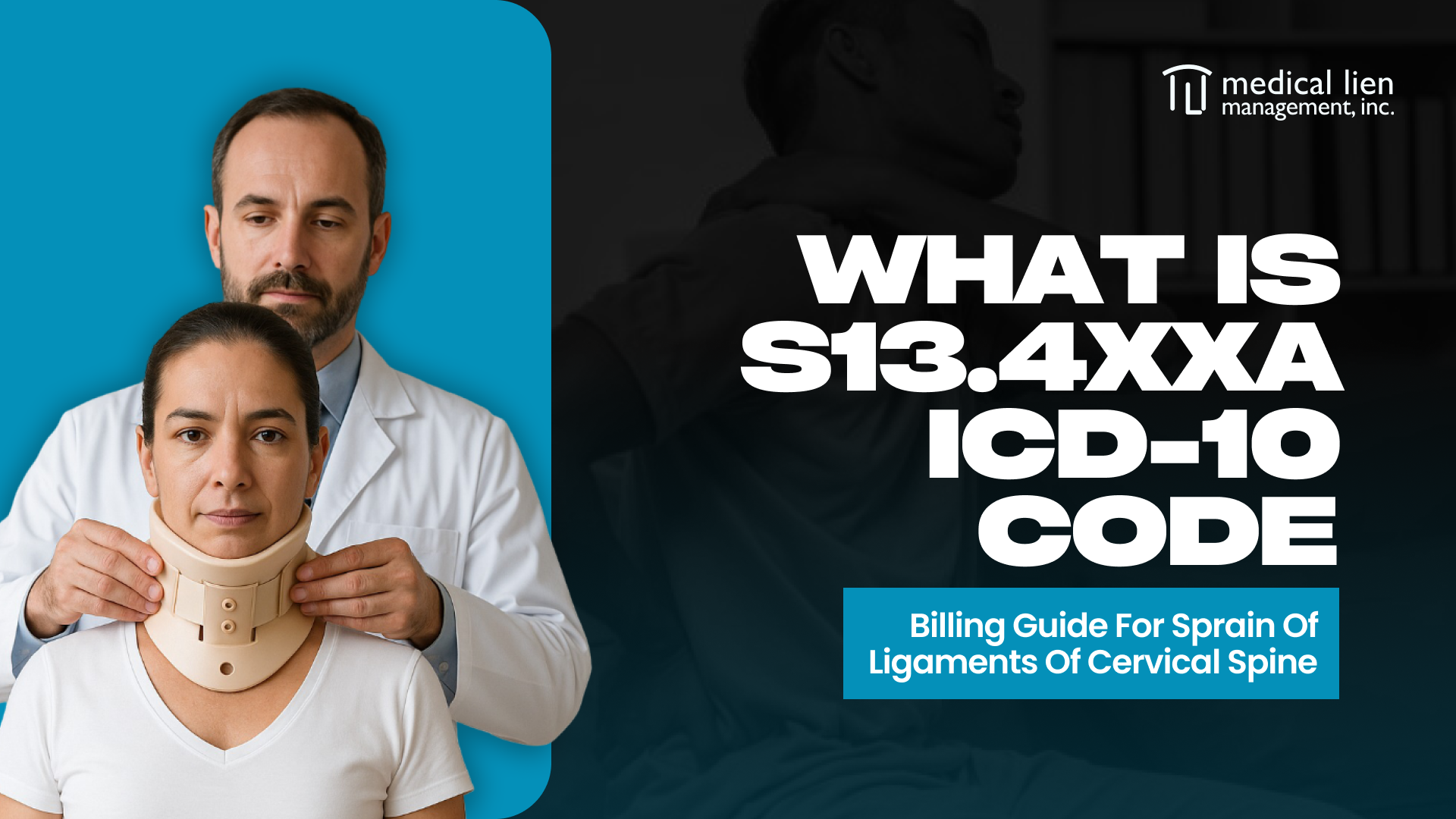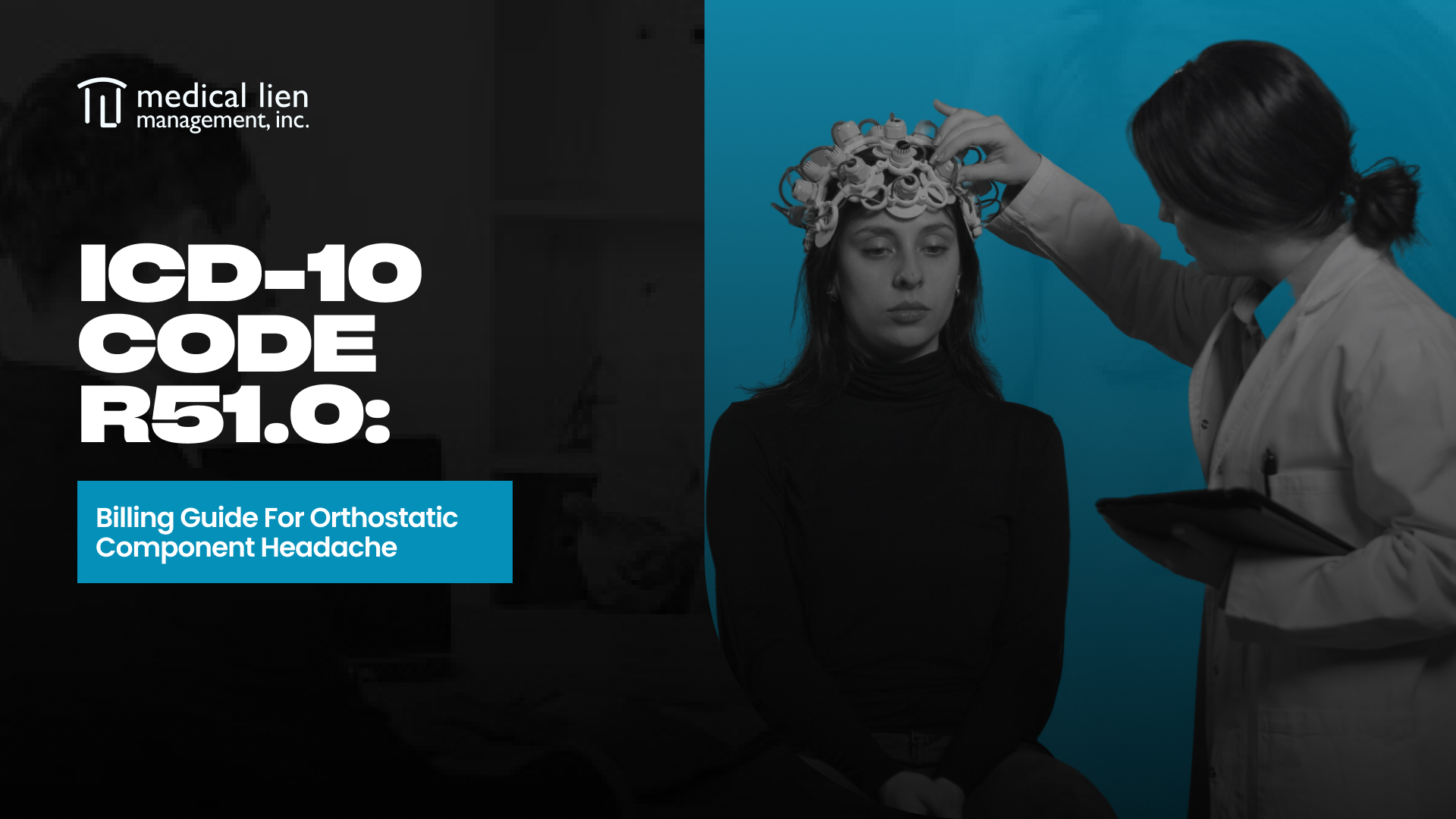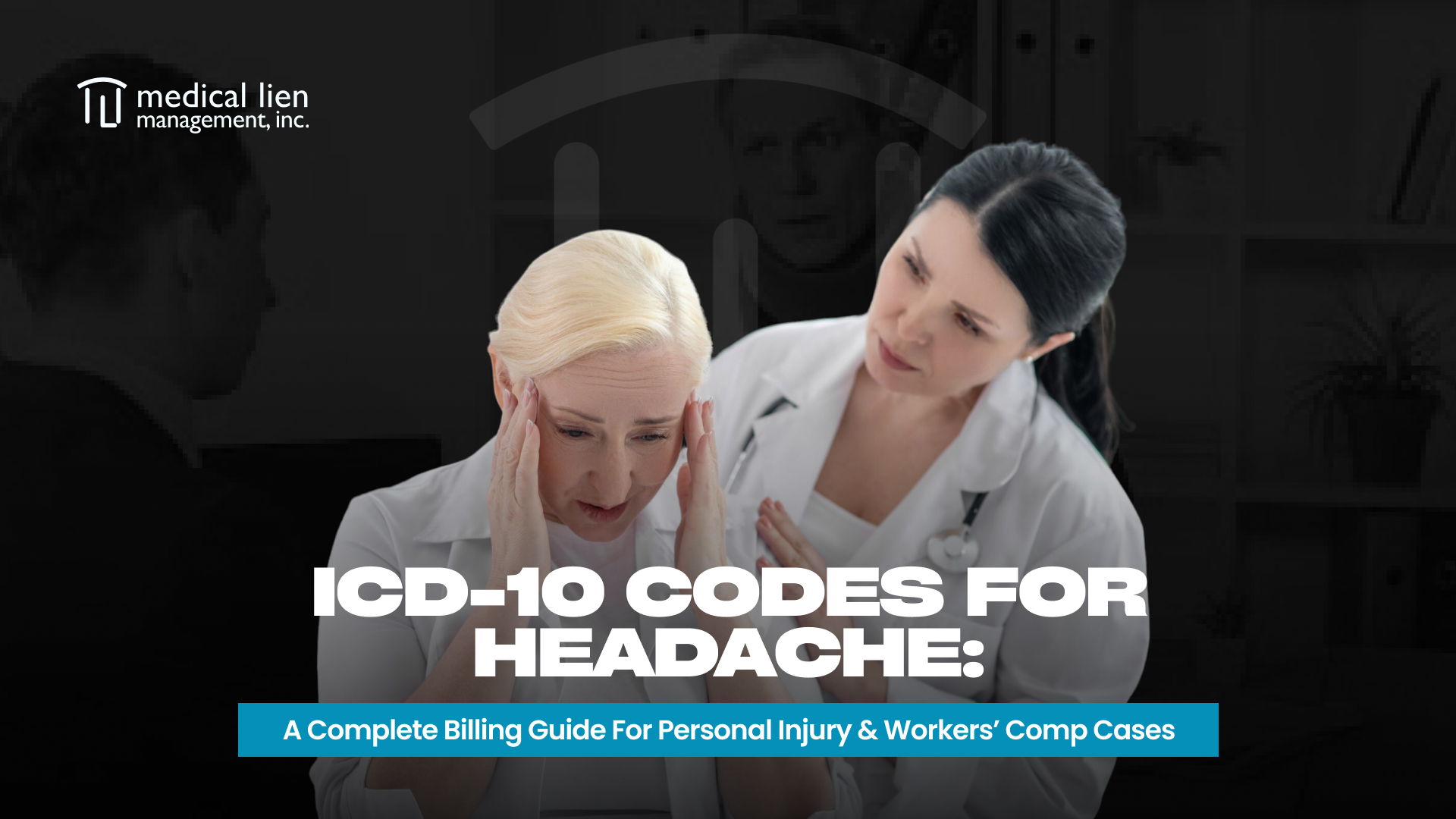If you’re a provider treating patients with neck injuries, particularly those resulting from auto accidents, workplace trauma, or falls, you’re likely familiar with the challenges of personal injury billing and reimbursement. And if you’re coding these encounters as simple neck pain or unspecified strain, you might be under-representing the severity of your patient’s condition, and leaving revenue on the table.
We agree that navigating ICD-10 coding for cervical spine injuries can feel unnecessarily complex, especially when you’re balancing patient care with documentation and legal considerations.
This article is your go-to guide for ICD-10 code S13.4XXA, covering everything from clinical definitions and coding dependencies to the CPT codes it supports and how to handle denials. You’ll learn how to protect your practice’s revenue, improve documentation, and strengthen your lien outcomes, backed by insights from professionals who have been doing this for over 30 years.
What is the S13.4XXA ICD-10-CM Diagnosis Code?
The ICD-10 code S13.4XXA is used to classify sprains of the ligaments in the cervical spine, typically caused by sudden trauma such as whiplash or accidents. This code helps ensure accurate documentation, supports billing and reimbursement, and establishes medical necessity when treating patients with neck injuries.
Clinical Description
- ICD-10 Code: S13.4XXA
- Diagnosis: Sprain of ligaments of the cervical spine
- Encounter: Initial encounter (denoted by the “A” at the end)
A sprain of the cervical spine occurs when one or more ligaments in the neck are overstretched or torn due to sudden trauma. It is a common result of rear-end motor vehicle accidents, often referred to clinically as whiplash.
Code Classification
- Chapter: Injury, poisoning and certain other consequences of external causes (S00–T88)
- Section: S10–S19 – Injuries to the neck
- Category: S13 – Dislocation and sprain of joints and ligaments at neck level
- Subcategory: S13.4 – Sprain of ligaments of cervical spine
Code Dependencies
This is a 7th character code, meaning that it requires a final character to indicate the type of encounter:
- A – Initial encounter
- D – Subsequent encounter
- S – Sequela
Only S13.4XXA is used for the first visit related to the injury.
Claims missing this character will be denied, even if everything else is correct.
When to Use S13.4XXA: Common Causes & Scenarios
Common Etiologies (Causes of Injury)
Cervical spine sprains typically occur in the following situations:
- Motor vehicle accidents (rear-end collisions)
- Falls or slips causing sudden neck movement
- Sports injuries involving contact or rapid deceleration
- Workplace injuries from lifting, twisting, or impact
- Assault or physical trauma
These injuries result in damage to the cervical ligaments, producing neck pain, stiffness, reduced range of motion, and sometimes headaches or dizziness.
Differentiating S13.4XXA from Similar Codes
Choosing the correct ICD-10 code is essential, not just for billing, but for legal defensibility and lien valuation.
| ICD Code | Description | Use When |
| M54.2 | Cervicalgia (neck pain) | Non-traumatic neck pain without ligament injury |
| S16.1XXA | Strain of muscle, fascia, and tendon at neck level | Soft tissue or muscular strain |
| S13.4XXA | Sprain of cervical spine ligaments | Confirmed ligament involvement due to trauma |
Using M54.2 for trauma-related injuries may appear vague or less serious, undermining case value in personal injury claims.
Is S13.4XXA a Billable Code?
Yes. S13.4XXAis a fully billable ICD-10 code, provided it is used appropriately and supported by clinical documentation. To ensure your claim is accepted:
- Include the correct 7th character (“A” for initial encounter)
- Document the mechanism of injury (e.g., car accident, fall)
- Note physical findings: limited ROM, tenderness, spasms
- Pair with accurate CPT codes for evaluation and treatment
Billable CPT Codes for ICD-10 S13.4XXA
Accurate CPT coding supports medical necessity and helps validate your ICD-10 diagnosis during lien negotiations, insurance reviews, and attorney communications.
Below is a curated list of CPT codes commonly billed with S13.4XXA.
| CPT Code | Description | Purpose |
| 99203–99205 | New patient office visits | Initial evaluation, including detailed exam and history |
| 99212–99215 | Established patient visits | Follow-up visits for ongoing care |
| 97110 | Therapeutic exercises | Improve strength, flexibility, and function |
| 97140 | Manual therapy | Soft tissue mobilization, joint mobilization |
| 97035 | Ultrasound therapy | Reduce pain and inflammation |
| 97530 | Therapeutic activities | Functional activities targeting ROM and coordination |
| 20552 | Trigger point injections | Used for muscle spasm and myofascial pain management |
| 95851 | ROM measurements | Objective documentation for cervical mobility |
| 72040 | Cervical spine X-ray | Rule out fracture, support diagnosis |
| 72141 | MRI of cervical spine | Advanced imaging when indicated for trauma |
These codes help paint a complete clinical picture, connecting the injury, symptoms, treatment, and expected outcome.
Other ICD-10 Codes Commonly Used for Cervical Spine Issues
- S16.1XXA – Strain of muscle, fascia, and tendon at neck level
- M54.2 – Cervicalgia (less specific, not trauma-related)
- S13.8XXA – Sprain of other parts of neck
- M50.20 – Other cervical disc displacement, unspecified level
Selecting the most accurate code ensures stronger claims, fewer denials, and better lien outcomes.
Why S13.4XXA is a Critical Code for Personal Injury Liens
In personal injury and workers’ compensation claims, the specificity of your ICD-10 coding directly influences lien negotiations and settlement outcomes.
Using S13.4XXA instead of vague alternatives like “neck pain” offers several advantages:
- Demonstrates the presence of trauma-related structural injury
- Supports treatment intensity and duration
- Justifies imaging, rehab, and pain management
- Strengthens the attorney’s case for higher compensation
- Increases the defensibility of your lien amount
When insurance adjusters review records, a diagnosis like S13.4XXA provides clear evidence of injury and removes ambiguity, which often leads to disputes or reductions.
Navigating Denials and Underpayments for S13.4XXA
Even when documented correctly, S13.4XXA claims can face delays, reductions, or outright denials, especially in personal injury (PI) and workers’ compensation (WC) cases.
Insurance adjusters and defense attorneys scrutinize every line item, and a lack of precision in your billing can result in significant revenue loss.
Common Reasons for Claim Denials
- Missing or Incorrect 7th Character
This code must include the appropriate 7th character, typically “A” for initial encounter. Omitting this detail will result in an automatic denial. - Insufficient Clinical Documentation
If your medical record doesn’t clearly explain the mechanism of injury or clinical findings, the diagnosis may be downgraded or considered “unsubstantiated.” - Use of Generic ICD Codes
Codes like M54.2 (cervicalgia) lack the specificity needed for trauma-based billing and may be interpreted as non-acute, leading to reduced reimbursement. - Lack of Correlation Between ICD-10 and CPT Codes
A diagnosis of cervical sprain without corresponding therapeutic or diagnostic CPT codes can raise red flags and cause payment delays.
How to Fight S13.4XXA Denials
If your claim is denied or reduced, here’s how to defend it:
- Step 1: Review the EOR (Explanation of Review)
Look for specific denial reasons: coding error, lack of documentation, unbundling, or “not medically necessary” flags. - Step 2: Submit a Second Bill Review (SBR)
In California, you can file a Second Bill Review within 90 days of receiving the EOR. Include corrected codes or documentation to strengthen your case. - Step 3: File for Independent Bill Review (IBR)
If the SBR is also denied, escalate to IBR within 30 days, accompanied by the $195 filing fee. If the ruling is in your favor, the payer must cover the fee. - Step 4: Ensure Legal Coordination
Keep the patient’s attorney in the loop, especially in lien cases. Their cooperation is key when negotiating full payment from a settlement.
Are You Being Underpaid for Your S13.4XXA Claims?
Treating PI or WC patients often means carrying the financial burden of care for months, or even years. While the legal process unfolds, your practice continues providing treatment, covering staffing, utilities, and administrative overhead.
This makes full reimbursement non-negotiable.
The Challenge with Cervical Sprain Liens
When S13.4XXA is not coded or supported correctly:
- Adjusters argue that treatment was excessive or unrelated to the incident
- Attorneys may reduce liens to increase client payouts
- Your lien may be last in line for settlement disbursement
If your documentation lacks precision or consistency, even a legitimate claim can lose priority during negotiations.
How Medical Lien Management Gets You Paid on Complex Cervical Claims
Medical Lien Management (MLM) has over 30 years of experience managing personal injury and workers’ comp liens, especially for spine-related injuries like cervical sprains.
Here’s how MLM protects and recovers your revenue:
- Accurate ICD-10 and CPT Coding
Our certified coders ensure that S13.4XXA is paired with the correct procedures, creating a clear, defensible link between diagnosis and treatment. - Complete Documentation Review
We review your notes, imaging, and encounter records to ensure your claims reflect objective findings and medical necessity. - Jet Filing for Faster Processing
MLM’s proprietary Jet Filing system streamlines claim submissions, reduces human error, and accelerates billing cycles. - Attorney Liaison & Legal Communication
We stay in direct contact with the patient’s legal team to track settlement progress and ensure your lien isn’t forgotten or unfairly reduced. - Appeals & IBR Support
If your claim is denied, our team handles the Second Bill Review and IBR process, so you don’t have to waste admin hours on follow-ups. - Transparent Case Tracking
You get a real-time view of where each case stands, no more wondering whether a claim was filed, followed up, or settled.
Conclusion
In high-stakes cases like personal injury claims involving cervical spine injuries, coding precision matters.
The ICD-10 code S13.4XXA offers:
- Clinical accuracy
- Legal defensibility
- Stronger lien valuation
- Better reimbursement outcomes
But using the code correctly requires proper documentation, matching CPT codes, and ongoing claim follow-up.
MLM brings decades of experience to every part of that process, helping providers get paid what they’re owed, on time and in full.
If you’re ready to protect your practice and improve collections for cervical spine injuries, connect with MLM today.
FAQs
What is diagnosis code S13.4XXA?
S13.4XXA is the ICD-10-CM code for a sprain of ligaments of the cervical spine, representing the initial encounter after a traumatic neck injury.
What is diagnosis code S13.4XXD?
S13.4XXD is the same diagnosis (cervical ligament sprain) but indicates a subsequent encounter, such as a follow-up visit or continued treatment after the initial injury.
What is diagnosis code S13.4?
S13.4 is the category code for “Sprain of ligaments of cervical spine.” It must be completed with appropriate 6th and 7th characters (e.g., S13.4XXA) to be valid and billable.
What is the ICD-10 code for whiplash injury of the neck?
Although there’s no single ICD-10 code labeled “whiplash,” most whiplash-type injuries are documented using:
- S13.4XXA – For ligament sprain
- S16.1XXA – For muscular strain
Selection depends on the tissue affected and the nature of the trauma.
What is the difference between a strain and a sprain in the neck?
- Strain: Involves muscles or tendons (e.g., S16.1XXA)
- Sprain: Involves ligaments (e.g., S13.4XXA)
A provider should differentiate based on clinical findings, mechanism of injury, and imaging where applicable.
Can I use S13.4XXA for a whiplash injury?
Yes, if the injury involves cervical ligament damage resulting from trauma like a car accident or fall. S13.4XXA is commonly used in whiplash cases when ligament sprain is confirmed or strongly suspected.
Get Paid in Full by Bringing Clarity to Your Revenue Cycle
Don’t let vague codes or incomplete documentation stand between you and proper reimbursement.
- Use S13.4XXA when it applies
- Document thoroughly
- Match with appropriate CPT codes
- Work with a billing partner who understands lien-based revenue recovery
MLM is here to help. Let’s simplify your cervical injury billing and maximize your collections, starting today.





